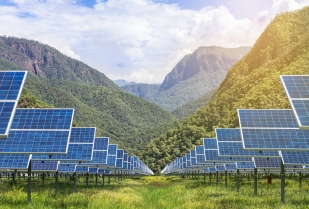Smart Grid: Evolving Electricity Networks for the Future
Basics
of the Grid
The grid is a network that connects electric power generation plants to high voltage lines which carry electricity over some distance to substations - "transmission". When a destination is reached, the substations decrease the voltage for "distribution" to medium voltage lines and then further to low voltage lines. Finally, a transformer on a telephone pole reduces it to a household voltage of 120 volts.
The overall grid can be thought of as composed of three major sections: generation (plants and step up transformers), transmission (lines and transformers operating above 100,000 volts - 100kV) and distribution (lines and transformers under 100kV). Transmission lines operate at extremely high voltages 138,000 volts (138kV) to 765,000 volts (765kV). Transmission lines can be very long - across state lines and even country lines.
For the longer lines, more efficient high
voltages are used. For example, if the voltage is doubled, the current is cut
in half for the same amount of power being transmitted. Line transmission
losses are proportional to the square of the current, so long line "losses"
are cut by a factor of four if the voltage is doubled. "Distribution"
lines are localized across cities and surrounding areas and fan out in a radial
tree-like fashion. This tree-like structure grows outward from a substation,
but for reliability purposes, it usually contains at least one unused backup
connection to a nearby substation. This connection can be quickly enabled in
case of an emergency so that a substation's territory can be fed by an
alternative substation.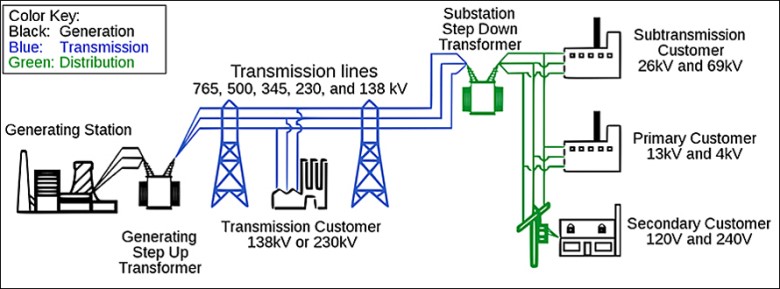
For back up purposes, transmission lines run in parallel and are interconnected with other transmission systems. In the US there are three major interconnected grid systems: those east of the Rocky Mountains, those west of the Rocky Mountains, and the state of Texas. However, back up is a two-way street. A catastrophic failure in one part of the grid can bring down a substantial section of the interconnected grid as happened in 2003 when a tree in Ohio brought down the grid all the way to New York City and parts of Canada. Since then operational improvements have been incorporated that hopefully will prevent another large domino-effect.
In the grid system, electricity is used in
real time as it is generated. That is, energy is being generated and used
simultaneously in the same amounts. Supply and demand on the grid must always
be in balance. There is almost no ability to store electricity. Also, it is
difficult for the grid to accommodate large, rapid changes in either load or
generation. Obviously, the load fluctuates quite a bit - both daily and
seasonally. However, with many cities connected together, small fluctuations
tend to cancel each other out. The aggregate demand normally behaves in a
relatively predictable manner. Based on the day of the year from historical
data and current weather forecasts, a next-day "load forecast" is
usually made by noon of the previous day. A minute by minute schedule is put
together for the generating plant and is adjusted in real time as the day
progresses. Very skilled operators monitor the actual load and make minute by
minute adjustments. They also carefully watch for any unusual happenings and
are trained to act accordingly.
Grid critics have long claimed that the nation's aging electrical network cannot support the enormous expansion of solar power and wind coming on stream as renewable resources are being dictated by many states and supported by the US Government. Solar and wind are somewhat unpredictable, especially wind. In Wyoming for example, huge wind plants are coming on board in the next few years. If the wind suddenly slows, it will cause large errors in the "daily forecasts" and make it difficult to manage the supply to the load. If the wind suddenly dies the load has to be taken up by standby gas plants. Because these traditional plants take considerable time to power up, they must be run in "spinning standby", i.e. running (and polluting) but not putting out any electricity. The heat from spinning standby is dumped into their cooling towers instead of generating electricity. These are some of the challenges facing the smart grid.
What
is a Smart Grid?
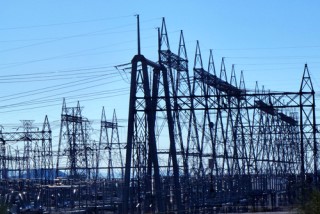 In celebrating the beginning of the 21st
century, the National Academy of Engineering set about identifying the most
important engineering achievements of the 20th century. The Academy compiled an
estimable list of twenty accomplishments which have affected virtually everyone
in the developed world. The internet took thirteenth place on this list, and
“super highways” eleventh. Sitting at the top of the list was national
electrification as made possible by the grid, “the most significant engineering
achievement of the 20th Century.”
In celebrating the beginning of the 21st
century, the National Academy of Engineering set about identifying the most
important engineering achievements of the 20th century. The Academy compiled an
estimable list of twenty accomplishments which have affected virtually everyone
in the developed world. The internet took thirteenth place on this list, and
“super highways” eleventh. Sitting at the top of the list was national
electrification as made possible by the grid, “the most significant engineering
achievement of the 20th Century.”
There are many visions of what a "smart grid" is. Consumers think of a smart grid as one where they have some intelligent influence over how much electricity they buy. Professionals in the utility industry think a smart grid is one that can react to sudden changes.
A smart grid is an umbrella term that covers the modernization of both the transmission and distribution grids. For the purpose of discussing a "smart grid" we will partition the grid into two sections:
- Transmission - networks including power generating plants over which power moves in bulk over medium and long distances. The networks are actively managed, power can move in both directions, and the transmission voltages are over 100 kV (kilo-volts).
- Distribution - local networks that traditionally moved power in one direction (towards customers). However, with the advent of customer generated rooftop power (or small wind farms), these networks are becoming bi-directional. Power lines operate under 100kV.
Transmission
Grid Improvements
High
Speed Monitoring of The Grid
 High speed sensors called Phasor
Measurement Units (PMUs) sample voltage and current many times a second at a
given location providing a detailed picture of the power system. Phasors create
representations of the various grid waveforms of alternating current, which
ideally in real time are identical everywhere on the network and conform to the
most desirable shape. With visibility over a wide geographical area, phasors
can ease congestion and bottlenecks, and can even mitigate large blackouts.
High speed sensors called Phasor
Measurement Units (PMUs) sample voltage and current many times a second at a
given location providing a detailed picture of the power system. Phasors create
representations of the various grid waveforms of alternating current, which
ideally in real time are identical everywhere on the network and conform to the
most desirable shape. With visibility over a wide geographical area, phasors
can ease congestion and bottlenecks, and can even mitigate large blackouts.
In the current grid, measurements are taken once every 2 or 4 seconds and are not synchronized across the system. Equipped with modern "integrated communication" links, phasor measurements are precisely time synchronized and taken 30 times per second. Clock pulses from GPS satellites are used to obtain precision time synchronized measurements over the covered area offering dynamic visibility into the system.
Research suggests that "wide area" PMU systems will revolutionize grid management by rapidly responding to negative system conditions (including terror attacks and blackouts). When an "abnormal" grid waveform is detected, it indicates that something is amiss.
Most of the time either a current surge is
present or a current drop is happening. In either case some form of corrective
action is necessary, and in some cases the system can do so automatically. In
the current grid system, much time is lost trying to figure out exactly what is
happening. Many in the power engineering community believe that the Northeast
Blackout of 2003 would have been contained to a much smaller area if a wide
area phasor network were in place.
Management
of Wind Power
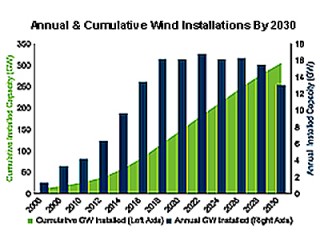 In 2006, President Bush and the Department of
Energy (DOE) proposed that by 2030, the US should obtain 20% of its electricity
from wind power. In 2009 wind accounted for only about 2% of the electricity in
the US. Electricity generated by wind is highly variable, both on an hourly
basis and seasonally. People think of July and August as the trying times for
the grid, but those hot days are quite predicable. It turns out that April and
October are the worst months from a management point of view as the wind
fluctuations are quite large.
In 2006, President Bush and the Department of
Energy (DOE) proposed that by 2030, the US should obtain 20% of its electricity
from wind power. In 2009 wind accounted for only about 2% of the electricity in
the US. Electricity generated by wind is highly variable, both on an hourly
basis and seasonally. People think of July and August as the trying times for
the grid, but those hot days are quite predicable. It turns out that April and
October are the worst months from a management point of view as the wind
fluctuations are quite large.
During winter the wind is rather strong and steady. During summer wind is weak and unchanging. When the wind suddenly begins to blow, a power surge is encountered on the grid. Likewise, when wind suddenly dies, there is a large power drop.
If the wind suddenly dies, the load normally
has to be taken up by combined cycle gas plants. Because these plants take
considerable time to power up, they must be run in "spinning
standby", i.e. running but not producing any electricity. Normally grid
operators have several generators in standby mode in case of a system failure
somewhere on the grid.
When wind is only 2% of the supply, variability is not a problem as 2% can be easily covered by existing standby capacity (normally 5%). As wind approaches 20% or more of total capacity, managing the variability becomes much more serious as much more capacity must be kept spinning or alternative back up arrangements must be made with adjacent providers.
In the past few years there have been two major studies of this problem - the Eastern (US) Wind Integration and Transmission Study (EWITS) and the Western Wind and Solar Integration Study (WWSIS). Both of these studies were multi-year efforts consisting of huge simulations using real wind data streams, prices of fuel, and actual placements of wind installations and fossil fuel generators. Both studies re-affirmed that 20% penetration of electricity demand by wind is technically feasible with minor improvements in current practices.
Penetration of 30% requires new transmission lines to be built and much more careful forecasting of wind conditions down to the 10-minute interval level. At 30% penetration, electricity operating costs would be reduced by approximately 40% as wind requires very little fuel.
At the end of 2017, Texas had more than
22,000 megawatts of wind power, more than triple Oklahoma’s 7,500 megawatts of
wind generating capacity, the second highest in the nation. A megawatt can
power roughly 200 homes during periods of peak demand. Analysts attribute much
of the state’s success to decisions to build transmission lines from wind
energy production areas in West Texas and the Panhandle to population centers
farther east. The $7 billion investment-built lines with the capacity to move
18,500 megawatts of power to wholesale power markets, according to the Electric
Reliability Council of Texas, which operates the state’s power grid.

Redirect
Power Using Intelligent Substations
A smart transmission grid must be able to redirect power across different transmission lines depending on load conditions. For example, there are two major transmission lines that deliver power from Quebec, Canada to New York City. One that goes through Albany is highly congested and overloaded.
The other which flows through the Catskill Mountains is underutilized. The world's most sophisticated high-power controller, which was installed by Siemens at the Marcy, New York substation, automatically pumps power from one transmission line to the other as required.
Intelligent high voltage controllers use very large "thyristor valves" (shown at the right) to switch mega-watts of power. Intelligent substations employing smart power controllers added to existing transmission grids to redirect power loads in and around congested areas would eliminate the need for terra-watts of new power generators through better efficiency of existing lines.
Adjust
Customer Loads
The total load connected to the grid can vary significantly over time. Although the total load is the sum of many individual choices of clients, the overall load is many times not a stable, slow varying, power curve. As mentioned above, generation can vary greatly from renewable resources due to rapid reductions in wind generation or cloud cover for solar. A temporary solution for this type of event is to automatically ask large business users to temporarily cut back their usage in return for an overall price reduction in their total usage. With two-way communications and intelligent controllers, this can and is being done with some large companies in California.
On the consumer side on Washington State’s Olympic Peninsula, a DOE (Department of Energy) project set up a sophisticated system that under duress responds to simple instructions by consumers in their preference profile. In the background, energy is centrally managed on the consumer’s behalf to save money and reduce the impact on the grid system. Consumers saved approximately 10% on their bills. More significantly, peak load was reduced by 15%, bringing the strained regional grid another 3 to 5 years of peak load growth and enabling the new installation of cleaner, more efficient generation units.
Distribution
Grid Improvements
Install
Intelligent "Business & Home" Internal Grids
 Consumer electronics devices now consume
over half the power in a typical US home. Other key devices that consume a lot
of electricity include air conditioning units, electric water heaters, electric
heating devices, pool pumps and other high wattage devices. A "consumer
grid" would connect all these devices to a simple programmable two-way
meter (similar to an ATM machine) connected to the local grid. A smart
"distribution grid" would then incorporate customer programmable
meters and could anticipate at least some customer behavior. This enables
customers to better control “intelligent equipment” and “smart appliances” in
businesses and homes enabling them to better manage their purchase of
electricity and reduce their energy costs.
Consumer electronics devices now consume
over half the power in a typical US home. Other key devices that consume a lot
of electricity include air conditioning units, electric water heaters, electric
heating devices, pool pumps and other high wattage devices. A "consumer
grid" would connect all these devices to a simple programmable two-way
meter (similar to an ATM machine) connected to the local grid. A smart
"distribution grid" would then incorporate customer programmable
meters and could anticipate at least some customer behavior. This enables
customers to better control “intelligent equipment” and “smart appliances” in
businesses and homes enabling them to better manage their purchase of
electricity and reduce their energy costs.
As an example, the city of Austin, Texas
has been working on building its smart distribution grid since 2003 when the
local utility first replaced one-third of its manual meters with smart meters
that communicate via a wireless network. Austin currently manages 500,000
devices real-time (smart meters, smart thermostats, and sensors), servicing one
million consumers and 43,000 businesses.
Installation
of Huge Numbers of Roof Top Solar Systems
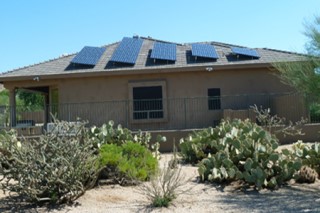 Although residential customers have been
installing solar systems for several years, the total of these installations is
very small in the overall market amounting to only one or two percent of total
residential electricity. However, as more and more states offer incentives to
go solar and as more utilities are forced to obtain more electricity from
"distributed sources", this is going to change the character of
"grid distribution". Today, the effect of distributed generation is
so small that utilities basically ignore it in their day to day operations,
except to install bi-directional meters for electricity credit purposes.
Although residential customers have been
installing solar systems for several years, the total of these installations is
very small in the overall market amounting to only one or two percent of total
residential electricity. However, as more and more states offer incentives to
go solar and as more utilities are forced to obtain more electricity from
"distributed sources", this is going to change the character of
"grid distribution". Today, the effect of distributed generation is
so small that utilities basically ignore it in their day to day operations,
except to install bi-directional meters for electricity credit purposes.
Post a Comment:
You may also like:
